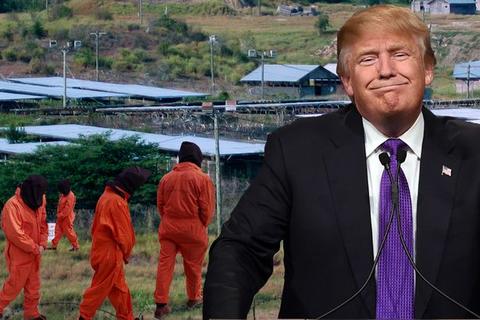Leak Reveals How, In Counter-Productive, Backwards Move, Donald Trump Plans to Issue New Executive Order Keeping Guantánamo Open

A photo collage of Donald Trump and Guantanamo.
If you can, please make a donation to support our work in 2018. If you can become a monthly sustainer, that will be particularly appreciated. Tick the box marked, "Make this a monthly donation," and insert the amount you wish to donate.
By Andy Worthington, January 26, 2018
The first responses that occurred to me when I saw the news, via Politico, that a leaked State Department cable has revealed that Donald Trump is planning to issue an executive order keeping the prison at Guantánamo Bay open — in other words, rescinding President Obama’s unfulfilled 2009 executive order pledging its closure — was, firstly, how leaky this administration is, and, secondly, how Trump seems obsessed with overturning anything associated with his predecessor.
Just a week into Trump’s presidency, last January, the New York Times obtained a leaked executive order in which he proposed to keep Guantánamo open, to prevent further prisoner releases, and to reintroduce torture and "black sites," rescinding not only Obama’s executive order regarding the closure of Guantánamo, but also his executive order banning the use of torture and ordering "black sites" closed.
He was shouted down on the latter, by everyone within the U.S. establishment who had been stung by how close they had come to prosecution over the brutal and unnecessary post-9/11 CIA torture program, which the Senate Intelligence Committee witheringly dismantled in its 2014 report. However, his desire to keep Guantánamo open never went away, even though advisers surely told him that sending anyone there was impractical, as the courts have a solid track record of successfully prosecuting those accused of terrorism, and Guantánamo’s history reveals it as little more than a place of torture and abuse, intended to be beyond the reach of the U.S. courts, which wrecks viable prosecutions, and, throughout its existence, has routinely warehoused insignificant prisoners at colossal expense.
In February, another leak revealed that Trump was planning to bring Islamic State prisoners to Guantánamo, raising problems regarding the scope of the detention policy that underpins Guantánamo’s existence — the Authorization for Use of Military Force, passed shortly after the 9/11 attacks, which covers al-Qaeda and the Taliban, but not IS. In August, officials told the New York Times that Trump was still undeterred, and was still hoping to expand the use of Guantánamo, a non-leak that broke with an established pattern of disgruntled officials working against the administration, whose contempt for the bureaucracy of government and its offices is, sadly, all too clear.
On the second point — Trump’s apparent hatred for Obama— it is hard not to conclude that it is motivated as much by racism as it is by a well-recorded vindictive streak in Trump’s character. Both, however, are demeaning traits to be expressed by the President of the United States.
As for a third point — the substance of the planned executive order — it is worth noting that, in practical terms, Guantánamo was not closing anyway. As Politico described it, "The order has limited practical effect: Obama was never able to make good on the order amid resistance from members of Congress, who blocked his efforts to move detainees to prisons in the United States and raised concerns that released inmates could revert back to terrorism."
However, as Politico also notes, "for Trump, it is a powerful political statement," fulfilling his campaign promise to keep the prison open, and to "load it up with bad dudes."
I don’t mean to underestimate how horrendous it will be if Trump goes ahead with his plans. If he does issue the executive order, he will be sending the world a message that he idiotically endorses the continued existence of the pointless and exhausted facility at Guantánamo Bay, which cripples the delivery of justice to the small number of men genuinely accused of terrorist crimes, and delivers only endless illegal purgatory to lower-level prisoners who should have been sent home long ago.
However, I concede that that is a message that, sadly, those of us working towards the prison’s closure for so many years have been unable to get across to the majority of the American people, who remain entranced by the Bush administration’s lies that Guantánamo held "the worst of the worst," and the minority of the American people who support Donald Trump and are happy for him to revive Guantánamo as though it has any purpose beyond expressing Islamophobia, racism, and contempt for the law.
In practical terms, the executive order is expected to be issued soon. Politico reported that "a person familiar with the issue" said that Trump was "expected to announce plans to sign the order during his State of the Union speech on Tuesday, or in the days before or after the address," and although the cable noted, "At this time, we are not aware of any plans to bring additional detainees to Guantánamo Bay," it also apparently "instructs U.S. diplomats to begin informing officials from other countries about the executive order after the State of the Union speech, though embassies in London, Paris, Berlin and a few other cities can begin filling in foreign governments on Monday 'with the request that they should not discuss the matter publicly until after the address.'"
The cable also "includes talking points designed to assuage the concerns of allies likely to criticize Trump’s decision." Politico added — both unnecessarily, and with a coyness typical of the U.S. mainstream media — that Guantánamo "is reviled in Europe and beyond as a symbol of U.S. excess in the fight against terrorists and the use of 'enhanced interrogation' techniques that critics equate with torture," but reading between the lines the mention of "talking points" is a clear concession that, if the executive order goes ahead, Trump will face serious criticism from allies around the world.
The cable also states that the executive order "does not signal a significant policy shift with respect to detentions. Rather, it affirms Guantánamo Bay will continue to remain open and serve as one of several options the United States maintains for the detention of terrorists." Following on from this, it is also noted that the executive order "will direct the Defense Department, in consultation with the State Department and other agencies, to 'recommend criteria to the President for determining detention disposition outcomes for individuals captured on the battlefield,'" also explaining that,
"Currently, the United States employs a number of different options for disposition, including transferring individuals to host governments or pursuing prosecution in a U.S. court," which "remain viable options."
While the above suggests an overall position in which little has changed, it is still to be hoped that Trump can be persuaded to walk back from officially endorsing the continued existence of a prison that has done so much over the last 16 years to tarnish America’s name as a nation founded on the rule of law, and which claims to respect the rule of law. Guantánamo’s continued existence mocks those claims every single day that it remains open.




